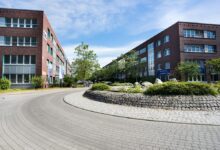The Essence of CBD: Unlocking the Central Business District’s True Meaning
Welcome to our insightful journey into the world of Central Business Districts (CBDs). In this article, we will delve into the true meaning and significance of these bustling urban hubs. Brace yourself for a captivating exploration of the economic epicenters that shape our modern cities. Join us as we uncover the essence of CBDs and unravel the secrets behind their success. Prepare to be inspired by the dynamic energy, vibrant culture, and unparalleled opportunities that these central districts offer. So, fasten your seatbelts and embark on this enlightening voyage with us.
1. Understanding the Central Business District: A Comprehensive Overview
Central Business Districts (CBDs) are the vibrant epicenters of urban life, encompassing the commercial, financial, and cultural core of a city. These dynamic areas are characterized by towering skyscrapers, bustling streets, and a hive of activity that sets them apart from other parts of the city.
A Brief Historical Background
The concept of a CBD dates back centuries, with its origins rooted in the growth of trade and commerce. Historically, CBDs developed around marketplaces and trading hubs, where merchants and businesses gathered to conduct transactions and exchange goods.
Over time, CBDs evolved and expanded, adapting to the changing needs of urban areas. They became the pulsating heart of cities, attracting businesses, financial institutions, and government offices, and serving as a magnet for economic activity.
Defining Characteristics of CBDs
CBDs are typically characterized by a unique set of features that distinguish them from other parts of the city. First and foremost, they boast a dense concentration of commercial buildings, including offices, retail establishments, and hotels.
Additionally, CBDs often showcase impressive architectural landmarks and iconic structures that shape a city’s skyline. These architectural marvels contribute to the visual appeal and grandeur of CBDs, attracting visitors and instilling a sense of pride in the local community.
Transportation connectivity is another key characteristic of CBDs. They are usually well-served by various modes of transportation, such as subway systems, bus networks, and major roads, facilitating easy access for commuters and visitors.
The Multifaceted Functions of CBDs
CBDs serve a multitude of functions that extend beyond their economic role. They often house important government institutions, such as city halls and administrative offices, making them centers of political power.
Furthermore, CBDs are cultural hotspots, hosting art galleries, museums, theaters, and concert halls. These cultural attractions contribute to the vibrancy and diversity of CBDs, attracting tourists and fostering a sense of community among residents.
The Socioeconomic Impact of CBDs
The socioeconomic impact of CBDs cannot be overstated. They are the engines of economic growth, generating employment opportunities and driving innovation. Businesses flock to CBDs to take advantage of the networking opportunities, access to talent, and proximity to other key players in their industries.
Moreover, CBDs contribute significantly to a city’s tax revenue, providing the financial resources necessary for public infrastructure development, social programs, and improvements in quality of life for residents.
The Future of CBDs
Looking ahead, CBDs are poised for continued evolution and transformation. As technology advances and urban planning principles evolve, CBDs will adapt to foster sustainable and inclusive development.
With the rise of remote work and the changing nature of businesses, CBDs may see a shift in their composition. Flexible workspaces, mixed-use developments, and an increased focus on environmental sustainability are expected to shape the future CBD landscape.
In conclusion, CBDs are complex urban entities that play a crucial role in the economic, social, and cultural fabric of cities. With their distinctive features, historical significance, and multifaceted functions, CBDs are essential components that contribute to the vibrancy and prosperity of urban areas.
2. The Evolution of CBDs: From Past to Present
Central Business Districts (CBDs) have undergone a remarkable transformation throughout history, adapting to the changing needs and aspirations of urban societies. In this section, we will explore the fascinating evolution of CBDs, from their humble beginnings to the dynamic economic powerhouses they are today.
From Marketplaces to Modern Business Hubs
The roots of CBDs can be traced back to ancient marketplaces, where merchants and traders gathered to exchange goods and conduct business. These early marketplaces laid the foundation for the commercial centers that would emerge in the future.
As cities grew and civilizations developed, CBDs became more structured and organized. In the medieval period, CBDs began to take shape around key landmarks such as town squares, where commerce thrived and administrative activities were centered.
The Rise of Industrialization and Skyscrapers
The advent of industrialization in the 19th century brought about significant changes in the urban landscape. As manufacturing and commerce expanded, CBDs experienced rapid growth and transformation.
One of the most notable developments during this period was the rise of skyscrapers. Enabled by advancements in engineering and construction, these towering structures revolutionized the urban skyline and became synonymous with CBDs. Cities such as New York City and Chicago became iconic for their impressive skyscrapers, which housed offices and symbolized progress and prosperity.
The Post-War Boom and Urban Renewal
After World War II, CBDs experienced a boom in development and witnessed the emergence of modern urban planning principles. The focus shifted towards creating efficient and functional business districts that could accommodate the growing needs of businesses and the workforce.
Urban renewal projects, such as the construction of modern office buildings and improved transportation infrastructure, revitalized CBDs and attracted businesses back to the city centers. These initiatives aimed to create vibrant and attractive environments that fostered economic growth and improved the quality of life for residents.
Towards Sustainability and Mixed-Use Developments
In recent decades, CBDs have faced new challenges and opportunities. The increasing awareness of sustainability and the need for environmentally conscious urban development have influenced the evolution of CBDs.
Today, CBDs are embracing mixed-use developments, integrating residential spaces, retail establishments, and recreational areas alongside commercial buildings. This approach aims to create more balanced and livable environments, reducing the dependence on commuting and promoting a sense of community within the CBD.
The Future of CBDs: A Blend of Tradition and Innovation
As we look to the future, CBDs are poised to continue evolving and adapting to the changing urban landscape. While technological advancements and remote work may impact the traditional concept of CBDs, their economic significance and cultural importance are expected to endure.
Efforts towards creating sustainable and smart cities will shape the future of CBDs, with a focus on energy-efficient buildings, smart infrastructure, and enhanced connectivity. CBDs will remain as vibrant economic centers, providing opportunities for businesses, fostering innovation, and serving as cultural hubs for generations to come.
3. The Economic Impact of CBDs: Driving Forces of Prosperity
Central Business Districts (CBDs) are not just architectural marvels and cultural hubs; they are also powerful engines of economic growth. In this section, we will explore the significant economic impact of CBDs and the driving forces behind their role as catalysts for prosperity.
Attracting Businesses and Fostering Entrepreneurship
CBDs have long been magnets for businesses, attracting companies from various industries seeking a competitive edge. The concentration of firms within CBDs creates a vibrant ecosystem that encourages collaboration, knowledge sharing, and innovation.
Moreover, CBDs provide unparalleled networking opportunities, allowing businesses to establish valuable connections with potential partners, clients, and investors. This conducive environment fosters entrepreneurship and supports the growth of startups, which contribute to job creation and economic vitality.
Generating Employment Opportunities
CBDs are major sources of employment, offering a diverse range of job opportunities across industries. The concentration of businesses in CBDs leads to a high demand for a skilled workforce, attracting talent from near and far.
Not only do CBDs offer employment opportunities within their office buildings, but they also create jobs in associated sectors such as retail, hospitality, and professional services. This employment multiplier effect generates economic stability and prosperity, benefiting both individuals and the community as a whole.
Stimulating Local and Regional Economies
The economic impact of CBDs extends beyond their immediate boundaries, benefiting local and regional economies. CBDs become economic drivers, attracting investments and generating revenue through taxes, fees, and other economic activities.
As businesses thrive within CBDs, they contribute to the growth of related industries such as real estate, construction, and professional services. This ripple effect leads to increased spending, job creation, and a boost in economic output for the entire region.
Enhancing Infrastructure and Urban Development
CBDs play a vital role in shaping urban development and infrastructure. The economic activities within CBDs generate revenues that can be reinvested into improving transportation networks, public spaces, and other essential infrastructure.
Additionally, the presence of CBDs often leads to the revitalization of surrounding neighborhoods and the creation of mixed-use developments. This urban renewal spurs further economic growth, increases property values, and enhances the overall quality of life for residents.
Fostering Global and National Competitiveness
CBDs contribute to the global and national competitiveness of cities and countries. The presence of a thriving CBD enhances a city’s reputation as a business-friendly destination, attracting foreign direct investment and fostering international trade.
Furthermore, CBDs serve as symbols of economic strength and progress, projecting an image of stability and prosperity on a national scale. They become showcases of innovation, entrepreneurship, and economic potential, attracting attention from investors, businesses, and tourists alike.
In conclusion, CBDs are economic powerhouses that drive prosperity at various levels. Through their ability to attract businesses, generate employment opportunities, stimulate local economies, enhance infrastructure, and foster global competitiveness, CBDs play a crucial role in shaping the economic landscape of cities and nations.
4. The Role of CBDs in Urban Planning: Designing Cities for Efficiency
Central Business Districts (CBDs) are not only economic powerhouses but also integral components in urban planning. In this section, we will explore the role of CBDs in designing cities for efficiency, functionality, and sustainable growth.
Strategic Location and Accessibility
CBDs are strategically located at the heart of cities, providing easy access to transportation networks and ensuring connectivity to surrounding neighborhoods. Their central position facilitates efficient commuting, reduces travel times, and minimizes congestion.
Urban planners carefully consider the location of CBDs to maximize accessibility for residents, employees, and visitors. Efficient transportation systems, such as subway lines, bus networks, and pedestrian-friendly infrastructure, are integrated into the urban fabric surrounding CBDs to ensure seamless mobility.
Mixed-Use Developments and Urban Density
CBDs often feature mixed-use developments, incorporating diverse functions within a compact area. This approach reduces the need for extensive travel between residential, commercial, and recreational areas, promoting a more sustainable and efficient use of space.
By concentrating activities and services in a centralized location, urban planners can achieve higher urban densities, which help optimize land use and reduce sprawl. Higher densities within CBDs also support public transportation systems, making them more economically viable and reducing reliance on private vehicles.
Economic Growth and Job Creation
CBDs are designed to foster economic growth and job creation. Urban planners strategically zone CBDs to attract businesses and promote a mix of industries that complement each other.
By clustering businesses within CBDs, urban planners facilitate knowledge exchange, collaboration, and innovation. This concentration of economic activity leads to increased productivity, job opportunities, and wealth creation for the local community.
Public Spaces and Quality of Life
Well-designed CBDs prioritize the creation of public spaces that contribute to the overall quality of life for residents and visitors. Urban planners incorporate parks, plazas, and pedestrian-friendly areas within the CBD to provide green spaces for relaxation, social interaction, and recreation.
These public spaces enhance the livability of the CBD, providing opportunities for outdoor activities, cultural events, and community gatherings. They serve as catalysts for social cohesion and contribute to the overall attractiveness of the CBD as a place to live, work, and play.
Sustainability and Environmental Considerations
Modern urban planning emphasizes sustainability, and CBDs play a significant role in this regard. CBDs are designed to minimize environmental impacts by focusing on energy-efficient buildings, sustainable materials, and green infrastructure.
Efforts to reduce carbon emissions, promote renewable energy sources, and incorporate green building practices are all key considerations in the planning and development of CBDs. These sustainability initiatives contribute to the overall resilience and environmental performance of the city as a whole.
In conclusion, CBDs have a crucial role in urban planning, ensuring cities are designed for efficiency, sustainability, and improved quality of life. Through strategic location and accessibility, mixed-use developments, economic growth, the creation of public spaces, and sustainability considerations, CBDs shape the urban landscape to create vibrant, functional, and livable cities.
5. Key Features of Successful CBDs: An In-Depth Analysis
Successful Central Business Districts (CBDs) are not just a product of chance; they possess certain key features that contribute to their prosperity and attractiveness. In this section, we will conduct an in-depth analysis of the characteristics that set successful CBDs apart from others.
Well-Designed Layouts and Infrastructure
One of the defining features of successful CBDs is their well-designed layouts and infrastructure. These districts are meticulously planned, with a clear vision of creating efficient spaces that foster economic activity.
Efficient road networks, well-connected transportation systems, and pedestrian-friendly infrastructure are all essential components of a successful CBD. Such features ensure smooth traffic flow, easy accessibility, and a pleasant environment for pedestrians, making the CBD a desirable place to work, visit, and do business.
Diverse Amenities and Services
Successful CBDs offer a wide range of amenities and services that cater to the needs and preferences of their diverse population. From high-end shopping malls and exclusive restaurants to affordable eateries and local markets, there is something for everyone within these districts.
CBDs often boast cultural facilities, such as theaters, art galleries, and museums, to enrich the overall experience of visitors and residents. The presence of green spaces, parks, and recreational areas further enhances the livability and enjoyment of the CBD.
Cultural and Architectural Significance
CBDs with a strong cultural and architectural significance tend to draw attention and captivate visitors. These districts often feature iconic landmarks, historic buildings, and architectural marvels that contribute to their unique identity and charm.
Preserving and celebrating the cultural heritage within the CBD adds character and a sense of place. It allows visitors and residents to connect with the history and traditions of the city, creating a deeper appreciation for the CBD and its surroundings.
Business-Friendly Environment
Successful CBDs cultivate a business-friendly environment that attracts companies and encourages entrepreneurship. This includes a supportive legal and regulatory framework, access to capital and financing, and incentives for businesses to thrive.
Additionally, successful CBDs often provide networking opportunities, incubation programs, and access to industry-specific resources. These initiatives foster collaboration, innovation, and the growth of startups, contributing to the overall vibrancy and success of the CBD.
Sustainable and Green Initiatives
In today’s world, sustainability is a crucial aspect of successful CBDs. These districts prioritize sustainable practices, incorporating green building designs, renewable energy sources, and environmentally friendly initiatives.
Successful CBDs often have comprehensive waste management systems, promote recycling, and encourage the use of public transportation and cycling. By prioritizing sustainability, CBDs contribute to the overall well-being of the environment and create a healthier, more livable city.
In conclusion, the key features of successful CBDs encompass well-designed layouts and infrastructure, diverse amenities and services, cultural and architectural significance, a business-friendly environment, and sustainable initiatives. These characteristics work in harmony to create thriving, vibrant, and attractive CBDs that leave a lasting impression on visitors and provide a high quality of life for residents.
6. CBDs Around the World: Uncovering Global Gems
Central Business Districts (CBDs) exist in various cities around the world, each with its unique characteristics, cultural influences, and architectural wonders. In this section, we will embark on a journey to uncover some of the global gems among CBDs, showcasing the diversity and vibrancy of these urban centers.
New York City’s Wall Street: The Financial Powerhouse
Located in the heart of Manhattan, Wall Street is synonymous with global finance and economic power. This iconic CBD is home to the New York Stock Exchange and serves as the financial hub of the United States, attracting major banks, investment firms, and multinational corporations.
With its towering skyscrapers and bustling streets, Wall Street represents the epitome of capitalism and serves as a symbol of American economic dominance.
Tokyo’s Marunouchi District: A Blend of Tradition and Modernity
The Marunouchi District in Tokyo seamlessly blends tradition with modernity, showcasing Japan’s economic prowess. This CBD is home to some of Japan’s largest corporations, including the headquarters of Mitsubishi and Tokyo Stock Exchange.
Marunouchi is known for its impressive mixture of historic buildings and sleek modern architecture, creating a captivating contrast that represents Japan’s ability to honor its rich heritage while embracing technological advancements.
London’s Canary Wharf: The Financial District of Europe
Canary Wharf, situated in East London, stands tall as the financial district of Europe. Once a bustling port, this CBD has transformed into a modern business hub, housing major financial institutions, including banks, insurance companies, and professional services firms.
Canary Wharf’s skyline is dominated by sleek glass towers, giving it a distinctive and futuristic feel. Its proximity to the River Thames adds to the charm, creating a unique blend of urban sophistication and waterfront beauty.
Sydney’s Central Business District: The Australian Icon
Sydney’s CBD, nestled around the iconic Sydney Harbor, is a vibrant and cosmopolitan district that embodies Australia’s dynamic economy. With its stunning views of the Sydney Opera House and Harbor Bridge, this CBD is a magnet for tourists and businesses alike.
The Sydney CBD boasts a mix of historic buildings and modern architecture, showcasing the city’s rich heritage as well as its forward-thinking nature. It is home to major corporations, cultural institutions, and a thriving arts and entertainment scene.
Dubai’s DIFC: Where Business Meets Luxury
In the heart of Dubai, the Dubai International Financial Centre (DIFC) stands as a testament to the city’s ambition and opulence. This CBD is a magnet for global finance and serves as a gateway between East and West.
The DIFC is known for its striking skyscrapers, luxury hotels, and high-end retail establishments. It showcases Dubai’s commitment to creating a business-friendly environment that attracts international companies and investors.
These are just a few examples of the remarkable CBDs that exist around the world. Each CBD has its own unique story, architectural marvels, and cultural influences, adding to the diversity and allure of these global gems.
7. The Social Fabric of CBDs: Cultivating Vibrant Communities
Central Business Districts (CBDs) are not only economic powerhouses but also vibrant cultural hubs that foster the creation of vibrant communities. In this section, we will delve into the social fabric of CBDs, exploring the diverse mix of people, lifestyles, and activities that make these districts thrive with energy.
A Melting Pot of Cultures and Diversity
CBDs attract people from all walks of life, creating a melting pot of cultures and diversity. Professionals, entrepreneurs, artists, and residents from different backgrounds come together within the CBD, contributing to a rich tapestry of experiences and perspectives.
The diversity within CBDs leads to a vibrant and inclusive atmosphere, fostering cultural exchange, understanding, and a sense of belonging. It is this diversity that gives CBDs their unique character and enriches the social fabric of these urban centers.
Cultural Attractions and Events
CBDs often house cultural attractions and host a wide array of events that cater to various interests. Museums, art galleries, theaters, and concert halls are just a few examples of the cultural institutions that thrive within CBDs.
These cultural attractions serve as gathering places for residents and visitors alike, providing avenues for artistic expression, entertainment, and intellectual stimulation. Festivals, exhibitions, and performances further enhance the vibrancy of CBDs, creating opportunities for people to come together, celebrate, and appreciate diverse forms of art and culture.
Thriving Entrepreneurial Spirit
CBDs are known for their entrepreneurial spirit, attracting individuals with ambitious dreams and innovative ideas. Startups, small businesses, and creative ventures find fertile ground within CBDs, benefiting from the supportive ecosystem and networking opportunities.
The presence of coworking spaces, incubators, and business development resources within CBDs fosters collaboration, mentorship, and knowledge sharing. This entrepreneurial environment not only drives economic growth but also contributes to a sense of community and shared goals among individuals pursuing their passions.
Public Spaces for Social Interaction
Successful CBDs prioritize the creation of public spaces that encourage social interaction and community engagement. Parks, plazas, and pedestrian-friendly areas within the CBD provide opportunities for people to gather, relax, and connect.
These public spaces become meeting points and venues for social activities, such as picnics, concerts, and outdoor events. They serve as catalysts for spontaneous conversations, friendships, and a sense of belonging within the CBD community.
Celebrating Local Businesses and Entrepreneurs
CBDs often take pride in showcasing local businesses and entrepreneurs, adding to the unique character and identity of the district. Farmers markets, local boutiques, and artisanal shops contribute to the vibrancy of CBDs, offering residents and visitors a chance to support local talent and craftsmanship.
By celebrating and promoting local businesses, CBDs nurture a sense of community pride and encourage economic sustainability. The success stories of local entrepreneurs inspire others and foster a spirit of collaboration and support within the CBD.
In conclusion, the social fabric of CBDs is woven by the diverse mix of people, cultural attractions, entrepreneurial spirit, public spaces, and celebration of local businesses. These elements create a sense of community, foster social interactions, and contribute to the vibrant and inclusive nature of CBDs.
8. CBDs and Sustainability: Paving the Way for Green Cities
Central Business Districts (CBDs) are at the forefront of the movement towards creating sustainable and environmentally conscious cities. In this section, we will explore how CBDs are paving the way for green cities through their commitment to sustainability and the adoption of eco-friendly practices.
Green Building Practices and Energy Efficiency
CBDs prioritize green building practices, incorporating sustainable design principles and energy-efficient technologies. Buildings within CBDs are constructed or retrofitted to meet stringent environmental standards, reducing energy consumption, and carbon emissions.
Features such as efficient insulation, energy-efficient lighting systems, and smart building management systems help minimize the environmental impact of CBDs. These sustainable practices not only reduce operating costs but also contribute to a healthier and more sustainable urban environment.
Promoting Renewable Energy Integration
Successful CBDs embrace renewable energy sources, such as solar and wind power, as part of their energy mix. They integrate renewable energy systems into their infrastructure, reducing reliance on fossil fuels and decreasing greenhouse gas emissions.
From solar panels installed on rooftops to wind turbines integrated into the urban landscape, CBDs demonstrate their commitment to a clean energy future. The adoption of renewable energy sources not only contributes to the sustainability of the CBD but also sets an example for other areas of the city to follow.
Efficient Public Transportation Systems
CBDs prioritize efficient public transportation systems to reduce congestion, improve air quality, and promote sustainable mobility. Well-connected subway networks, bus systems, and cycling infrastructure offer residents and workers convenient alternatives to private vehicles.
By encouraging the use of public transportation, CBDs minimize traffic congestion and the associated environmental impacts. This commitment to sustainable transportation options helps create a more livable and environmentally friendly city.
Waste Management and Recycling Initiatives
Sustainable CBDs place a strong emphasis on waste management and recycling initiatives. They implement comprehensive waste management systems, including recycling programs, composting facilities, and efficient waste collection and disposal methods.
Through these initiatives, CBDs aim to reduce landfill waste, promote recycling, and encourage responsible consumption habits among residents, workers, and visitors. Waste management and recycling efforts contribute to a cleaner, healthier, and more sustainable environment for the CBD and its surrounding areas.
Promoting Green Spaces and Biodiversity
CBDs recognize the importance of green spaces and biodiversity in creating sustainable and livable cities. They prioritize the integration of parks, rooftop gardens, and urban greenery within the CBD, providing residents and visitors with access to nature.
These green spaces not only enhance the aesthetic appeal of the CBD but also improve air quality, support biodiversity, and provide opportunities for relaxation and recreation. CBDs become havens of tranquility amidst the bustling urban environment.
In conclusion, CBDs are leading the charge towards creating green cities through their commitment to sustainability. By embracing green building practices, promoting renewable energy integration, prioritizing efficient public transportation systems, implementing waste management initiatives, and promoting green spaces, CBDs set an example for other areas of the city to follow. They pave the way for a more sustainable future, where cities prioritize the well-being of both the environment and their residents.
9. The Future of CBDs: Embracing Innovation and Technological Advancements
The future of Central Business Districts (CBDs) is poised to be filled with innovation and technological advancements. In this section, we will explore how CBDs are adapting to meet the evolving needs of businesses and residents, and how they are embracing the potential of emerging technologies.
Smart City Technologies and Infrastructure
CBDs are at the forefront of adopting smart city technologies to enhance efficiency, connectivity, and sustainability. These technologies utilize data and connectivity to optimize resource management, improve transportation systems, and enhance the overall quality of life within the CBD.
Smart city initiatives include intelligent lighting systems, smart parking solutions, and real-time data analytics to monitor and manage energy consumption, traffic flow, and public services. These advancements not only improve operational efficiency but also contribute to a more sustainable and livable CBD.
Autonomous Transportation and Mobility Solutions
The future of CBDs is set to witness the integration of autonomous transportation and mobility solutions. Self-driving vehicles, electric scooters, and bike-sharing schemes are just a few examples of the innovations that will revolutionize urban mobility within CBDs.
Autonomous transportation systems offer the potential for reduced congestion, improved safety, and increased accessibility. CBDs will become testbeds for these technologies, as they provide controlled environments with well-defined infrastructure and high demand for transportation services.
Flexible Workspaces and Remote Work
The rise of remote work and flexible work arrangements is reshaping the way CBDs function. As more companies embrace remote work policies, CBDs are adapting to provide flexible workspaces that cater to the changing needs of businesses and individuals.
CBDs are transforming office spaces to accommodate a hybrid work environment, with collaborative areas, shared workspaces, and advanced connectivity. These flexible workspaces foster collaboration, innovation, and networking opportunities, even for those who work remotely.
Digital Connectivity and 5G Networks
As the demand for digital connectivity continues to grow, CBDs are preparing to embrace the power of 5G networks. The implementation of 5G technology within CBDs will provide ultra-fast internet speeds, low latency, and increased capacity for data transfer.
This enhanced connectivity will enable the seamless integration of smart devices, Internet of Things (IoT) applications, and immersive technologies. It will revolutionize the way businesses operate, residents interact, and visitors experience the CBD, creating a truly connected and digital ecosystem.
Environmental Sustainability and Green Initiatives
The future of CBDs will place an even stronger emphasis on environmental sustainability and green initiatives. CBDs will continue to adopt renewable energy sources, implement green building practices, and prioritize waste reduction and recycling.
Efforts to create zero-carbon CBDs, promote circular economies, and increase biodiversity within urban environments will take center stage. CBDs will become showcases of sustainable development, setting an example for other areas of the city and inspiring a global movement towards environmental consciousness.
In conclusion, the future of CBDs is exciting and filled with promise. With the integration of smart city technologies, autonomous transportation, flexible workspaces, digital connectivity, and a strong commitment to environmental sustainability, CBDs are poised to lead the way in creating innovative, connected, and sustainable urban environments.
10. Unlocking the Potential: Seizing Opportunities in CBDs
Central Business Districts (CBDs) offer a wealth of opportunities for businesses, entrepreneurs, and individuals alike. In this final section, we will explore how to unlock the potential of CBDs and seize the opportunities they present.
Establishing a Presence for Businesses
For businesses, CBDs provide a prime location to establish a presence and thrive. The concentration of commercial activity, access to a skilled workforce, and networking opportunities make CBDs ideal for startups, multinational corporations, and everything in between.
When considering establishing a business in a CBD, it’s essential to research the specific industry clusters and market dynamics within the CBD. Identifying target markets, understanding competition, and leveraging the resources and support available in the CBD will help businesses maximize their success.
Expanding and Scaling Up
CBDs provide a fertile ground for expanding and scaling up businesses. The diverse talent pool, access to funding, and potential collaboration opportunities within the CBD ecosystem can fuel growth and innovation.
Entrepreneurs looking to expand their ventures can explore partnerships, seek investment opportunities, and tap into the expertise available within the CBD. Building relationships with other businesses, industry associations, and government agencies can open doors to new opportunities and propel growth.
Networking and Collaboration
CBDs are hubs of networking and collaboration, offering countless opportunities to connect with like-minded professionals, potential clients, and industry experts. Attending events, joining business organizations, and participating in industry conferences within the CBD can lead to valuable connections and partnerships.
Building a strong professional network within the CBD allows individuals to tap into the knowledge, expertise, and resources of others. Collaborative projects and partnerships can lead to innovation, new business ventures, and personal growth.
Exploring Career Opportunities
For individuals seeking career opportunities, CBDs are rich with possibilities. The concentration of businesses within the CBD creates a demand for a diverse range of skills and expertise.
Job seekers can leverage the networking and recruitment events within the CBD to connect with potential employers. They can also explore the job opportunities in various industries thriving within the CBD and align their skills and aspirations accordingly.
Embracing the Vibrant Lifestyle
Beyond the professional realm, CBDs offer a vibrant lifestyle for residents and visitors. The cultural attractions, entertainment options, and diverse culinary experiences within CBDs create a dynamic and enriching environment.
Residents can immerse themselves in the local culture, enjoy the arts, attend events, and explore the culinary scene. CBDs often offer a wide range of recreational activities, including parks, fitness centers, and social clubs, ensuring a well-rounded and fulfilling lifestyle.
In conclusion, CBDs are teeming with opportunities waiting to be seized. Whether it’s establishing a business, expanding existing ventures, networking, exploring career prospects, or embracing the vibrant lifestyle, CBDs provide a platform for success and personal growth. By tapping into the resources, networks, and support available within the CBD, individuals and businesses can unlock their full potential and thrive in these bustling urban centers.
In conclusion, Central Business Districts (CBDs) are more than just commercial hubs; they are vibrant epicenters that shape the economic, social, and cultural fabric of cities. From their historical origins to their future potential, CBDs have undergone remarkable transformations and continue to evolve to meet the needs of modern urban societies.
With their well-designed layouts, diverse amenities, and strategic locations, CBDs attract businesses, foster entrepreneurship, and generate employment opportunities. They stimulate local and regional economies, enhance infrastructure, and drive innovation. CBDs also cultivate vibrant communities, celebrating diversity, promoting cultural attractions, and providing spaces for social interaction and collaboration.
As we look toward the future, CBDs are embracing innovation and embracing sustainable practices. They are integrating smart city technologies, autonomous transportation, and flexible workspaces. CBDs are also prioritizing environmental sustainability, promoting renewable energy, and implementing green initiatives.
The opportunities within CBDs are vast and varied, whether it’s establishing a business, expanding existing ventures, networking, exploring career prospects, or embracing the vibrant lifestyle. By unlocking the potential within CBDs, individuals and businesses can thrive and contribute to the continued success and growth of these urban centers.
So, whether you’re an entrepreneur looking to make your mark, a professional seeking new horizons, or a resident immersing yourself in the energy of CBD life, CBDs offer a world of possibilities. Embrace the opportunities, connect with the vibrant communities, and seize the potential that awaits within Central Business Districts.

I am a passionate and dynamic entrepreneur and the creative force behind “Bile Business,” a blog dedicated to exploring the ever-evolving world of business. With a keen eye for innovation and a relentless drive for success, John has established himself as a thought leader in the business realm.









